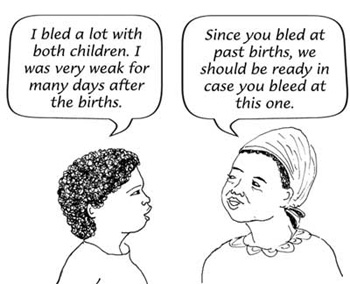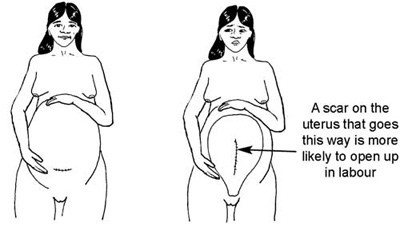Has she had any problems with past pregnancies or births?
If a woman has had problems with past pregnancies or births, she may have problems with this birth too. Ask the mother to tell you the story of each of her past pregnancies and births. Let her tell you everything: the good and bad. Then ask the following questions to learn more about problems in past pregnancies, and what to be prepared for during this one. Write down what you learn. All these problems are explained more fully in other study sessions in this Module.
Was she tired or weak or anaemic?
Extreme tiredness or weakness in pregnancy is usually caused by anaemia (see Box 8.1 earlier). If she had anaemia in another pregnancy, she is likely to have it again this time.
Did she have high blood pressure, swelling or convulsions?
If she had high blood pressure in a past pregnancy, she is likely to get it again. High blood pressure can be a sign of pre-eclampsia (see Box 8.2 earlier). Check her blood pressure and other signs of pre-eclampsia regularly and be prepared to refer her to a hospital if it develops.
If she had convulsions in a past pregnancy or birth, she probably had eclampsia (Box 8.2), and she should definitely give birth in a hospital.
Did she have diabetes?
If she had diabetes (too much sugar in the blood) in a past pregnancy, she is more likely to get it again. When blood sugar is too high, some of it gets into the urine when the blood is filtered in the kidneys. You should be able to test a pregnant woman's urine to see if there is sugar in it. (We teach you how to do this in Study Session 9.) A more reliable test can be done at a health facility. Diabetes can lead to miscarriage, or other problems with the mother or baby after birth.
Did she have a very long labour or a long pushing stage?
Was her labour longer than 24 hours for a first baby, or longer than 12 hours for other babies? Did she push for more than two hours? Was the baby in a difficult position or very big? Was she very afraid? Ask if her long labour caused problems for her or her baby. If that birth was safe for her and the baby was OK, then she will probably not have a problem with this birth. If that birth was difficult, ask her if she knows why the labour was long. Did she have anaemia?
Did she have fistula?
If she had a long labour, did it cause a fistula (an abnormal opening communicating between the vagina, and either the urinary bladder, or the rectum, or the urethra, or the ureter)? This is more likely to happen in women who had the harmful traditional practice of female genital mutilation when they were children. Urine or stools pass through the fistula into the vagina and leak out continuously, unless the fistula is closed by a surgical operation.
Past history of a fistula means she should definitely have this birth in a hospital.
Did she have a very short labour (less than 3 hours)?
If the mother had a very short labour in the past, make sure that she and her family know what to do if you do not get there in time, and they cannot get her to a health facility. You can teach the family how to deliver a baby in an emergency. You will learn how to do this in the next Module, Labour and Delivery Care.
Did she have an early birth?
If she had a baby born more than a month early, ask her if she had a discharge from her vagina. This could be a symptom of a vaginal infection, which can lead to early births. Be ready in case this baby is early too, and watch for signs of labour, described in the next Module, Labour and Delivery Care.
Did she have a small baby (less than 2.5 kilograms or 5 pounds)?
Find out if the baby was born early (it is normal for early babies to be small). If the baby was small but it came on time, ask the mother if she had anaemia (Box 8.1), high blood pressure, or pre-eclampsia (Box 8.2). Also ask if she had enough to eat, or if she smoked cigarettes, or used drugs. Any of these things could have made the previous baby small.
Check the size of her abdomen to see if this baby is growing normally. (You will learn how to do this in Study Session 11.) If you think this baby may be very small for its gestational age, the mother should give birth in a hospital, because small babies can develop more health problems than normal weight babies. (The Module on Postnatal Care will explain why, and what you can do to help.)
Did she have a big baby (over 4 kilograms or 9 pounds)?
Ask if the birth was difficult. If it was not, this birth will probably be OK too. But having a large baby may be a sign that the mother has diabetes. Check carefully to see if this baby seems big too. Test her urine for sugar, and if possible have the mother tested for diabetes in a health facility.
Can you explain why the baby may grow large if the mother has diabetes?
Did she have heavy bleeding before or after the birth?
If she bled a lot in a past pregnancy or birth, it is more likely to happen again. Ask her to tell you as much as she can remember about her bleeding. Did she need medical help? Was she anaemic afterwards? Was she too weak to stand? The answers to these questions will help you prepare for what may happen at this birth. Be ready to treat her for heavy bleeding after the birth. The Module on Labour and Delivery Care will explain how to do this.
If possible, a woman who bled heavily before should have this baby in a hospital.

Did she have any problems with the placenta (afterbirth)?
It is better if a woman who had a retained placenta after a previous birth gives birth in a hospital next time.
If the woman's placenta did not come out easily in a past birth, she may have the same problem again. Tell her to watch out for signs of bleeding during this pregnancy, and to seek help from a health professional immediately if it happens.
Did she have a fever or infection of the vagina or uterus?
This birth may be fine, but if she had an infection of the vagina or uterus during or after a previous birth, she has more risk of infection again this time. Be sure to check her for signs of vaginal infection. (Study Session 9 explains how to do this.)
Was she very sad (depressed) after the birth?
Postnatal depression is a serious health problem and she must be referred to the next level health facility.
If a woman became depressed after a past birth, it may happen again. Be prepared to help if this happens. (Counselling is covered in Study Session 14.)
Did the baby get sick or die before, during or after the birth?
If you think there may be a risk to her next baby, refer her to the nearest health facility.
Find out everything you can about the circumstances of the baby's sickness or death. If the woman was seen by health professionals at the time, what did they tell her had caused it? Does she have her own ideas about what happened, and why?
Did her baby have birth defects?
Some birth defects just happen and no one knows why. Others run in the family. Ask about the type of birth defect and if anyone else in her or the baby's father's family has that birth defect. The next baby may have the same problems. Some defects are caused by illnesses like herpes or rubella. If the woman had herpes or rubella in a past pregnancy, reassure her that these infections will probably not cause birth defects in this pregnancy. Pregnant women should try to avoid contact with people who are sick. Other causes of birth defects are exposure to toxic chemicals, drugs or medicines, or they may be due to poor nutrition during the pregnancy. Eating a healthy diet in pregnancy is covered in Study Session 14.
Did she have caesarean surgery (birth by operation)?
In caesarean surgery a doctor cuts open the woman's belly and uterus to get the baby out. Sometimes a caesarean surgery is done because the baby does not fit through the mother's pelvis. Sometimes it is done because the baby is in danger and must be born very quickly. After the baby is out, the doctor sews the uterus and belly closed. This leaves one scar on the uterus and a second scar on the belly (Figure 8.5).
It is safest for a woman who has had a previous caesarean to give birth in a hospital again next time.

Most women can have a safe vaginal birth even if they had a caesarean birth with a previous baby. But there is a very small chance that the scar on the uterus may tear open (rupture) during labour. If this happens, the woman will bleed inside and she and her baby could die.